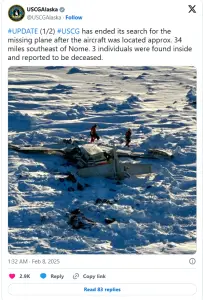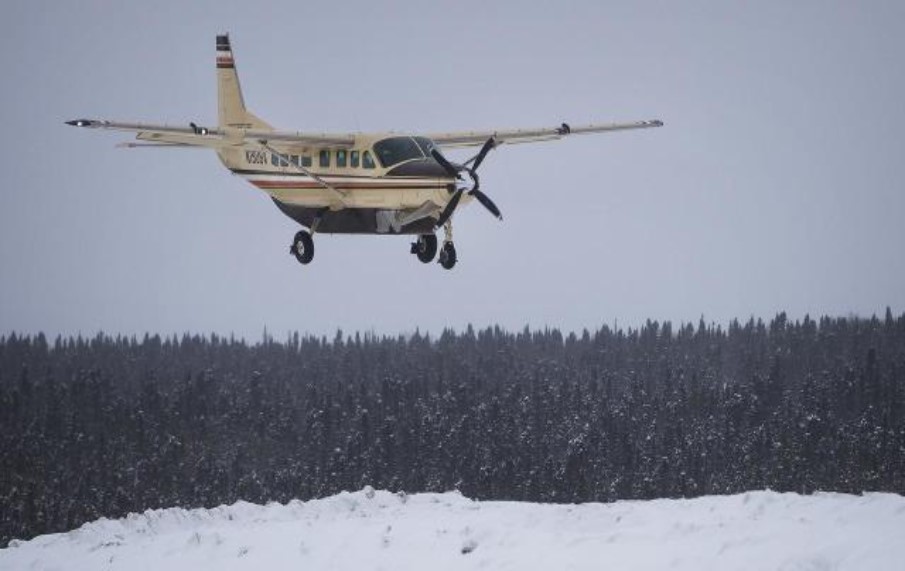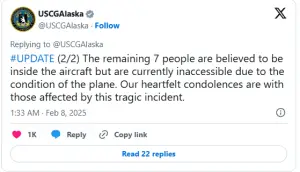On Thursday afternoon, the serene skies over Alaska took a sudden and unsettling turn when a Cessna 208B Grand Caravan, operated by Bering Air, vanished without a trace. The aircraft, carrying ten people, had departed from Unalakleet at 2:37 p.m., with a scheduled route to Nome. The small passenger plane was en route over the vast expanse of Norton Sound when its last recorded position was logged at 3:16 p.m. FlightRadar, a tracking tool commonly used for real-time flight data, captured the final signal from the plane at that time. Just moments after this timestamp, the aircraft disappeared from radar.
The disappearance triggered immediate concern among authorities, loved ones, and the team at Bering Air. As the plane vanished from sight, the flight’s crew and passengers were left in a state of profound uncertainty. With no further updates and no indication of what had occurred, the moments following the loss of contact were filled with anxiety and fear. In the world of aviation, particularly in remote regions like Alaska, situations like this are rare, yet the inherent dangers of the rugged terrain and unpredictable weather conditions raise the stakes dramatically.
David Olson, the Director of Operations for Bering Air, confirmed the loss of contact and immediately began working with search and rescue teams to locate the aircraft. Olson expressed the deep concern felt by the company and the families of those aboard the plane. “It’s an incredibly challenging situation, and our team is focused on doing everything we can to locate the aircraft,” Olson stated in a briefing to the press. The company, along with local authorities and Alaska State Troopers, mobilized quickly to search the region where the plane’s last known position was recorded.
The aircraft had been flying over Norton Sound, a body of water that is notoriously difficult to navigate, especially when combined with Alaska’s unpredictable weather patterns. The region’s vast, remote landscape can make search and rescue operations more complicated, with limited infrastructure and rough terrain posing additional challenges to responders. The uncertainty of the situation added to the growing distress for the families awaiting news of their loved ones. With such a significant gap in information after the plane’s disappearance, hopes for a quick resolution dwindled, leaving loved ones and officials to brace for the worst.

The response to the disappearance came from a coordinated effort of both local and federal agencies. Alaska State Troopers worked alongside the Coast Guard and other first responders to conduct aerial and ground searches in the area around Norton Sound. With difficult conditions complicating the search, the task was far from simple, but authorities remained committed to locating the missing aircraft as quickly as possible.
Family members, many of whom were anxiously waiting in Unalakleet and Nome, were forced to cope with the agonizing uncertainty. Some had already started to gather near the airfields, hoping for any sign of news, while others took to social media in an effort to receive updates. As the hours passed, frustration and concern mounted. The isolation of the region compounded the emotional strain, and loved ones clung to the possibility that the search efforts would soon yield results.
Bering Air, a regional carrier that frequently operates flights in remote areas of Alaska, had built a reputation for safety and reliability. This incident was deeply unsettling for both the airline and the communities it served. The small passenger aircraft, the Cessna 208B Grand Caravan, is often used for regional flights in Alaska due to its ability to operate in challenging conditions. With this aircraft’s disappearance, the impact on the local community was felt deeply, as residents waited anxiously for news.
At the same time, officials in Nome and Unalakleet worked to maintain clear communication with the public, ensuring that both residents and family members stayed informed on the progress of the search. As rescue teams scoured the waters of Norton Sound and the surrounding terrain, there was a quiet hope that the plane had experienced an issue that could have led to a controlled descent, though the lack of contact made it impossible to be certain.
The disappearance of the Cessna 208B Grand Caravan served as a stark reminder of the dangers faced by aviation operators in Alaska. Despite the challenges posed by geography and weather, search teams continued their tireless efforts, hoping for a breakthrough that would bring clarity to the tense and tragic situation. With each passing hour, the search continued, driven by the hope that the missing aircraft would be found, and the passengers aboard would be safely brought back to their loved ones.

